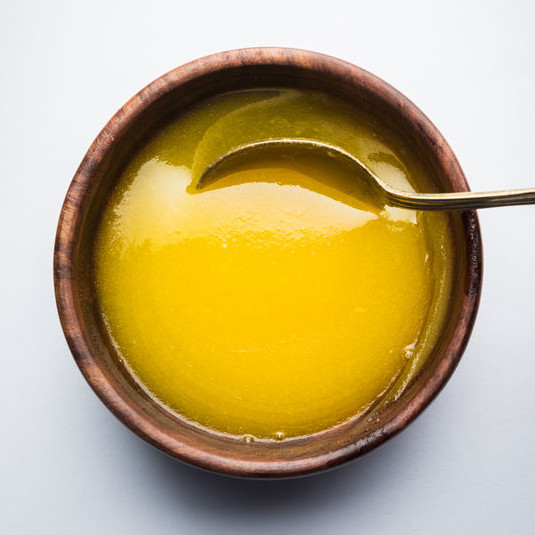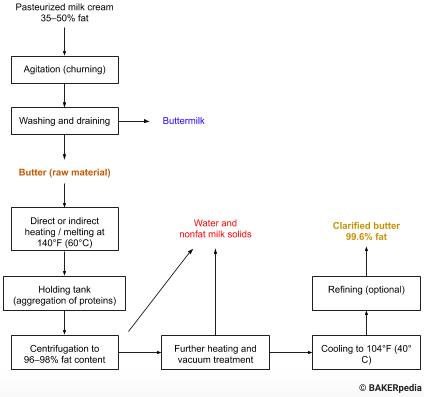
Clarified Butter
Also known as anhydrous milkfat, anhydrous butteroil, ghee or liquid gold
What is Clarified Butter?
Clarified butter is anhydrous milkfat that has been separated from the nonfat milk solids and water normally found in butter.1
Although both clarified and regular butter can be used in the same applications, the absence of water gives clarified butter more consistency, higher stability and longer shelf-life by restricting microbial growth and spoilage reactions such as lipolysis and oxidation.2
Origin
Clarified butter, commonly known as ghee in India or “liquid gold” in the Middle East, has been around for centuries. It is used instead of butter in many food preparations, like sautés, and in local bakery products, such as Naan bread in Pakistan and Afghanistan, chapati in Northern India, and pancakes in South India and Sri Lanka.3
During World War II, large quantities of this butter were produced and used as a spread by the Allied troops. Subsequently, the production of clarified butter increased rapidly, especially in regions with large surplus of butter.1
Function
Clarified butter is a flavorful and tasty fat that is considered premium in certain applications. Its unique flavor is due to many factors, mainly heat treatment, presence of short chain fatty acids, and small amounts of diacetyl (0.1 to 2 ppm). Its strong yellow to golden color is due to the pigment β-carotene.1,2
Contribution of clarified butter to foods and bakery products include its use as:
- Frying fat: although less efficient than specialized deep-fat frying shortenings and vegetable oils, it has a higher smoke point than regular butter. Also, it’s less likely to degrade or burn upon heating.
- Formula fat or oil (melted)
- Spread in foods
- Cooking medium for sautés
- Aroma and flavor enhancer and carrier in bakery products
Commercial production
Clarified butter makes use of thermal and physical processes. Butter is first heated, centrifuged and vacuum-treated.4 The following block diagram helps visualize the production process.

Application
Clarified butter can be used in the production of ice cream, bakery products such as puff pastry, croissants, and Danish pastry, as well as confectionery. It is considered an important commodity in different food aid programs given its high shelf stability.
The following compares the composition of regular butter and clarified butter:2
| Component | Butter (%) | Clarified butter (%) |
| Fat | Min 80 | Min 99.6 |
| Moisture* | 15–17 | Max. 0.3 |
| Salt | 1.5–2.0 | Max. 0.05 |
| Nonfat milk solids** | 1.0 | Max 0.1 |
* Whey water
**Comprised of minerals, protein (casein and whey proteins) and lactose
Specifications:2
- Peroxide value: max. 0.6 meq oxygen / kg fat
- Free fatty acid (FFA) content, expressed as oleic acid: max. 0.4% (w/w). Use of alkali to neutralize free fatty acids is permitted in some countries.
- Texture: smooth with fine granules to liquid consistency, depending on temperature
- Color: intense yellow or gold when liquid, and pale whitish yellow when solid (crystallized)
- Storage: fat crystals formed in stored ghee may sink to the bottom of the container, leaving a clear oily supernatant.
- Clarified butter is liquid at temperatures above 97°F (36°C) and solid below 61–63°F (16–17°C).
Nutrition and health
Compared to regular butter, clarified butter contains more calories per gram. Regular butter contains water, which does not provide calories, and milk solids that provide less calories than pure fat.
Strictly speaking, clarified butter is a concentrated form of butterfat, so one can expect a higher level of saturated and unsaturated fatty acids. It also contains higher levels of fat-soluble vitamins, such as vitamin A, D and E.
Regulation
Clarified butter sold as ghee is regulated by the Agricultural Marketing Service (Dairy Division) of the U.S. Department of Agriculture (USDA).6
References
- Mortensen, B.K. “Anhydrous Milk Fat/Butter Oil and Ghee.” Encyclopedia of Dairy Sciences, 2nd Edition, Volume 1, Academic Press, Elsevier Ltd., 2011, pp. 515–521.
- Chandan, R. “Production and Specifications of Milk Concentrates.” Dairy-Based Ingredients, Eagan Press Handbook Series, AACC International, Inc., 1997, pp. 23–39.
- Rajah, K.K. “Spreadable Products.” Fats in Food Technology, 2nd edition, John Wiley & Sons, Ltd, 2014, p. 213.
- Bylund, G. “Anhydrous Milk Fat (AMF) and Butteroil.” Dairy Processing Handbook, Tetra Pak Press, 2019, pp. 293–299.
- United States Department of Agriculture (USDA). Agricultural Marketing Service (AMS). Dairy Product Quality Specifications, https://www.ams.usda.gov/grades-standards/dairy-product-quality-specifications. Accessed 23 June 2019.

